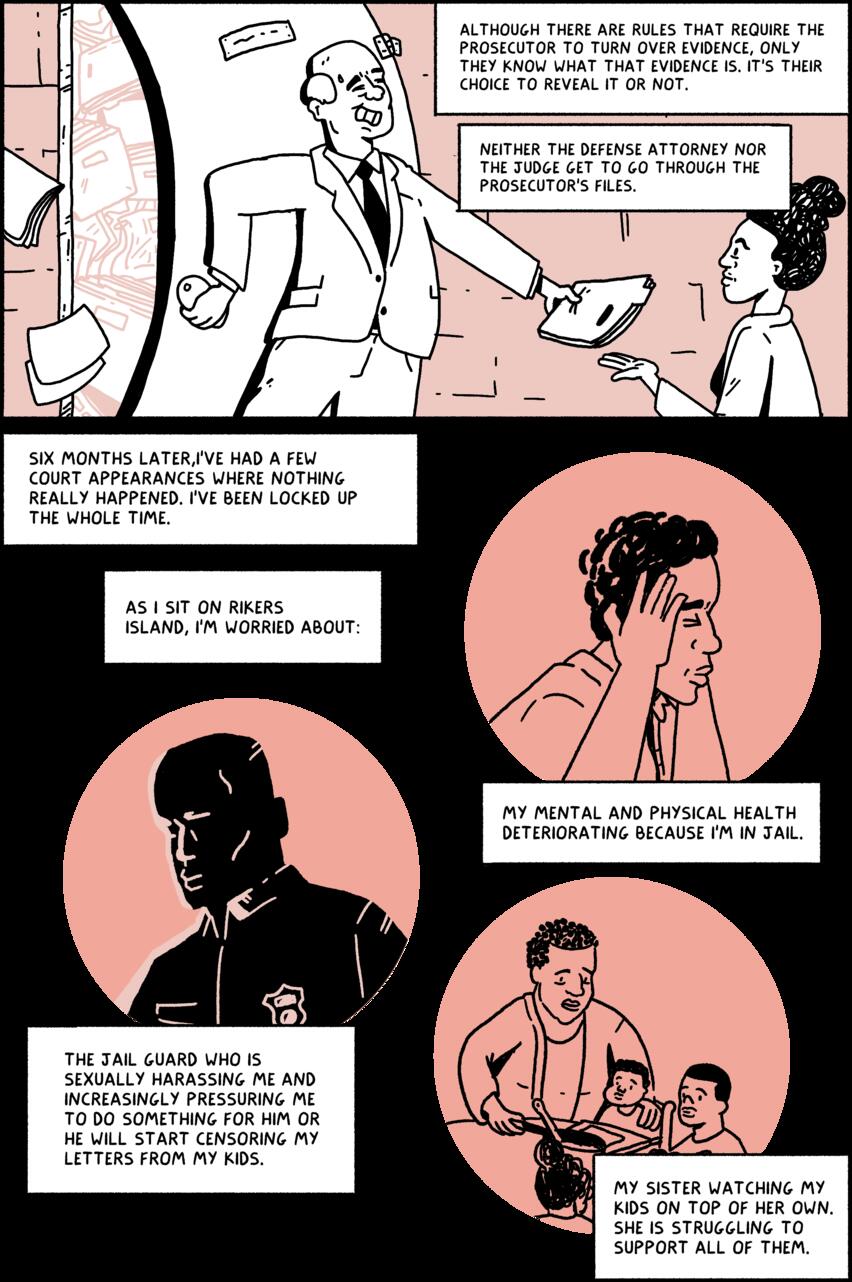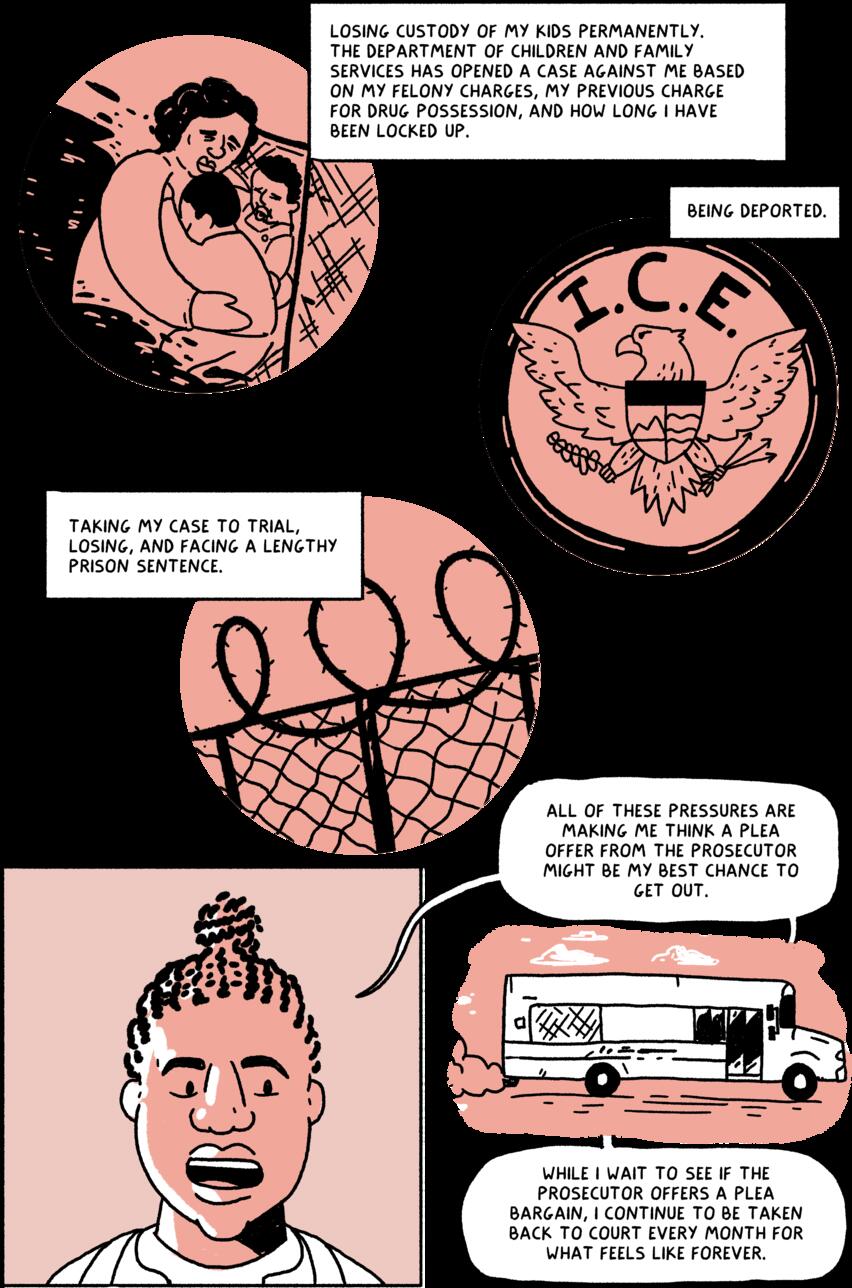Court Appearances
For more information on court appearances, visit Criminal Court 101: Court Appearances.
The following section describes Esther’s experience during the court appearances phase of her case. A panel shows the repetitive nature of court appearances, with a jail cell on one side and a court on the other. Arrows create a cycle of return between the two. Esther describes how this cycle affected her: “After the grand jury’s indictment, I had recurring court appearances until the case was over. At my first court appearance, Maya and I spoke briefly before seeing the judge.” A panel shows Maya walking down a hallway to meet Esther in a courtroom holding cell. In the next panel, Esther sits alone in the holding cell. Maya approaches and says, “We don’t have much time, Esther, but I wanted to give you a quick update. I’m in the process of collecting as much evidence as I can. I’m still trying to get the security footage they showed to the grand jury. When I get a sense of the evidence we’ll know whether we should take a chance going to trial or try to negotiate a plea deal with the prosecutor.” Esther looks up at Maya. “Okay,” she says. “What is going to happen today?”
Maya begins explaining. “Well, I am going to file a motion asking the prosecution to turn over any internal documents it has about the police officer and security guard involved in your case.” As she speaks, the panel shows email inboxes, pictures of the officer and guard, and pieces of a computer screen. She continues. “There are many cops and security officers with a history of lying or misconduct and I’m thinking there may be some emails between folks in the prosecuting office about the two in your case.” Looking out of her cell at Maya, Esther asks, “How will I know if you find anything while I’m at Rikers?” Maya responds, saying “Unfortunately, we’ll have to wait until the next time we can talk in person.” Their conversation ends, and present-day Esther returns to narrate the difficulties she and Maya faced “We never did see all the evidence in the prosecution’s possession. Even months later when I took a plea, and despite the motion Maya filed, the prosecutor still didn’t turn over the documents. As we waited, the court put pressure on us to resolve the case, and the prosecutor threatened to go harsher if we kept pushing for evidence.”
As present-day Esther continues narrating, the panel shows a prosecutor holding back the door of an evidence room. The door is bursting with files and papers. He hands a single, solitary folder to Maya. Esther continues. “Although there are rules that require the prosecutor to turn over evidence, only they know what that evidence is. It’s their choice to reveal it or not. Neither the defense attorney nor the judge get to go through the prosecutor’s files.” “Six months later, I’ve had a few court appearances where nothing really happened. I’ve been locked up the whole time.” Circular panels show the various problems on Esther’s mind. “As I sit on Rikers Island, I’m worried about: My mental and physical health deteriorating because I’m in jail.” The panel shows Esther, distressed and clutching her head. She continues: “The jail guard who is sexually harassing me and increasingly pressuring me to do something for him or he will start censoring my letters from my kids.” A panel shows a guard, mostly in shadow. His face is not discernable. “My sister watching my kids on top of her own. She is struggling to support all of them.” The panel depicts Esther’s sister putting a pot of food down at a table, where both of their kids sit. She is tired.
Esther continues describing the issues on her mind. “Losing custody of my kids permanently. The Department of Children and Family Services has opened a case against me based on my felony charges, my previous charge for drug possession, and how long I have been locked up.” A panel shows Esther hugging her two children. “Being deported.” The panel depicts the logo for Immigration and Customs Enforcement, also known as ICE. “Taking my case to trial, losing, and facing a lengthy prison sentence.” The panel shows a barbed wire fence. Esther continues narrating. “All of these pressures are making me think a plea offer from the prosecutor might be my best chance to get out. There is a vignette drawing of the correctional facility bus Esther rides on between Rikers and the court. Concluding the section on Court Appearances, Esther says, “While I wait to see if the prosecutor offers a plea bargain, I continue to be taken back to court every month for what feels like forever.” The Court Appearances section of Esther’s Story ends here.



